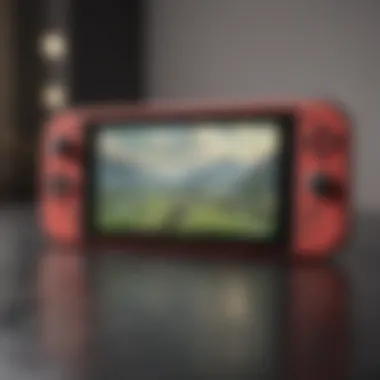Understanding the Differences in Nintendo Switch Models


Intro
The Nintendo Switch family has dominated the gaming landscape since its launch. Among these models, the Nintendo Switch Lite stands out. This handheld console caters to a specific audience. In this article, we explore how the Switch Lite differentiates itself from other versions of the Nintendo Switch.
Many gamers are keen to understand the nuances in design, functionality, and overall gaming experience. Understanding these differences allows players to make informed choices. It is essential to recognize how each model aligns with individual gaming preferences.
In this exploration, we will discuss key aspects that separate the Nintendo Switch Lite from traditional models. The examination includes features that contribute to gameplay, design considerations, and performance metrics. As we dive deeper into these points, it becomes apparent that choosing the right Nintendo Switch model can greatly impact your gaming enjoyment.
Game Reviews
Overview
Game reviews of popular titles reveal how well they perform on different consoles. Since the Nintendo Switch Lite is handheld only, it aligns closely with portable gaming experiences. This aspect can influence how games are received and enjoyed by players.
Gameplay
The type of gameplay offered on the Nintendo Switch Lite presents a unique perspective. Titles designed with handheld functionality often shine in this environment. Games that utilize touch controls or simple button layouts tend to cater well to this model.
Storyline
Storylines across games available on the Switch Lite remain equally engaging as those on its counterparts. Players can expect rich narratives whether they choose to play games like The Legend of Zelda: Link’s Awakening or Animal Crossing: New Horizons.
Graphics
Graphics quality on the Lite model holds up against other versions. However, some titles may experience sharper visuals on the standard Switch due to the larger screen size and TV connectivity. Players should consider the visual experience they prefer when choosing their console.
Soundtrack
Sound design is essential in creating immersive gaming experiences. The Nintendo Switch Lite provides quality audio through its built-in speakers and headphone jack. However, it lacks the additional sound experience that comes with docked play on other Switch models.
Pros & Cons
Pros:
- Lightweight and portable design
- Affordable price point
- Purchase includes a solid library of games
Cons:
- Compatible only with handheld mode
- No removable controllers
- Lacks certain features found in regular models
Final Verdict
In evaluating the Nintendo Switch Lite, it is crucial to consider personal gaming habits. Players who prioritize portability will likely appreciate the design. However, those who enjoy multiplayer experiences may find limitations.
"Understanding the specific strengths and weaknesses of the Nintendo Switch Lite can greatly impact your gaming enjoyment."
End
As we assess the Nintendo Switch Lite against its counterparts, it's clear that each model offers distinct advantages. Whether choosing based on design, performance, or gameplay preference, understanding these differences assists in making an informed decision.
Foreword to Nintendo Switch Models
The Nintendo Switch has revolutionized the gaming landscape since its inception. Understanding the various models, including the Nintendo Switch Lite, is crucial for potential buyers and enthusiasts alike. This exploration reveals how each model caters to different gaming needs and preferences. This section sets the stage for a detailed comparison of the Nintendo Switch family.
Overview of Nintendo's Game Consoles
Nintendo has a rich history of creating iconic game consoles. From the NES to the Wii, each system has marked significant advancements in gaming technology and player experience. The Nintendo Switch line has continued this tradition, merging portability and power. The family includes the original Nintendo Switch, the Nintendo Switch Lite, and the Nintendo Switch OLED model. Each model serves a unique purpose, appealing to various gaming audiences. The performance differences, weight, and design features are pertinent aspects that will be discussed in this article.


The Evolution of the Nintendo Switch
The Nintendo Switch, launched in March 2017, was designed to cater to a growing desire for flexibility in gaming. It allows players to transition from handheld play to TV mode seamlessly. Over time, Nintendo has expanded this lineup. The Switch Lite, introduced in September 2019, focuses on handheld gaming, offering a lighter and more accessible option. This evolution showcases Nintendo's commitment to adapt and innovate in response to shifting consumer preferences, while maintaining a solid library of games across all models.
Design Features
The design features of the Nintendo Switch Lite provide significant insights when comparing this model to its counterparts. Design does not only complement the visual appeal but also affects user experience, usability, and overall satisfaction with the device. Key aspects of design such as physical dimensions, color variations, and construction quality play a crucial role in making an informed decision for gamers and enthusiasts. Understanding these elements can help potential buyers choose the model that best fits their specific needs and preferences.
Physical Dimensions and Weight
The physical dimensions and weight of the Nintendo Switch Lite are important for portability and comfort. The Lite version is compact, primarily aimed at handheld play. It has a smaller footprint compared to the original Nintendo Switch and the Nintendo Switch OLED model. Specifically, the Switch Lite measures approximately 3.6 inches in height, 8.2 inches in width, and 0.55 inches in depth. Its weight is around 0.61 pounds, making it lighter than its counterparts.
This lightweight nature is particularly beneficial for extended gaming sessions, allowing players to hold the console with less strain. For those frequently on the move or who prefer gaming on-the-go, the ability to easily pack it in a bag or carry it around is a significant advantage. It may not have the bulk or additional features found in other models, but for many users, this makes it an ideal choice for portable gaming.
Color Variations and Aesthetics
Aesthetics often influence a customer's choice. The Nintendo Switch Lite presents several color options that cater to a diverse audience. Available colors include yellow, turquoise, gray, and coral. These distinct colors create a personalized experience, allowing users to own a console that reflects their personality. The aesthetic appeal doesn't just end with color; the design is sleek, minimalistic, and modern.
Contrasting with the larger Switch models, which are equipped with detachable controllers, the Lite has built-in controls that integrate seamlessly into its design. The aesthetic choices highlight Nintendo's move towards a child-friendly image while still appealing to adults. Whether for casual play or as a collector’s item, the Switch Lite's appearance is designed to attract.
Construction Quality
The construction quality of the Nintendo Switch Lite is vital to its durability and user experience. Nintendo employs high-quality materials, ensuring that the console withstands everyday use. Its plastic exterior is designed to be robust while keeping the device lightweight. The buttons and controls feel sturdy, offering satisfying feedback during gameplay.
However, it is worth noting that while the Switch Lite holds up well against casual use, it is essential to handle it with care due to its all-in-one design. Unlike the original Switch, which has a more rugged design with detachable parts, the Lite requires users to be cautious, particularly during transportation. The choice of materials and build quality reflects Nintendo's intent for the device to serve primarily as a handheld console, aimed at gamers who prioritize portability over versatility.
In summary, the design features of the Nintendo Switch Lite, including its dimensions, color choices, and build quality, set it apart in the landscape of gaming consoles. These elements significantly impact user experience and essential for any discerning gamer to consider.
Functionality Comparison
The functionality of the Nintendo Switch Lite in relation to its counterparts is a vital aspect to evaluate. This comparison sheds light on how each model serves its user base, with notable differences in gaming experience, usability, and overall versatility. Understanding these differences can assist gamers and enthusiasts in selecting the right system based on their lifestyle and gaming preferences.
Handheld Mode vs TV Play
One primary feature of the Nintendo Switch family is its ability to function in both handheld and television modes. The Nintendo Switch Lite, however, is strictly a handheld device.
- This limitation means users cannot connect it to a TV.
- Players interested in a multi-use device may find the standard Nintendo Switch more appealing.
When prioritizing a portable gaming experience, the Lite excels. Players can game on-the-go without worrying about docking or setup. The gameplay is straightforward, meeting the needs of those who enjoy gaming during commutes or travel. The standard Nintendo Switch, contrastingly, offers more versatility. Users can switch between playing on a big screen or in handheld mode, providing flexibility based on the environment.
Built-in Controls and Customization
Built-in controls on the Nintendo Switch Lite are integral to its design. The Lite features a compact layout, enabling easier handling during extended gaming sessions. However, this design comes at a cost.
- Customization options are more limited than its counterparts, which offer detachable Joy-Con controllers.
- The standard Nintendo Switch permits players to modify their controls according to personal preference for additional comfort.
For users who love to tailor their gaming experience, the Lite's offerings may seem insufficient. Yet, casual gamers who desire simplicity may appreciate the fixed controls. They eliminate the need for extra equipment, making it a straightforward option for newcomers.
Connectivity Options
Another aspect to consider is the connectivity options available on each model. The Nintendo Switch Lite offers essentials, but it lacks some advanced features.
- The standard Nintendo Switch supports wired and wireless connections, useful for multiplayer scenarios.
- Options like compatibility with additional peripherals can enhance gameplay for serious gamers.
Switch Lite users may find a lack of LAN capabilities limiting for online play. Whereas the standard version supports multiple network options, allowing seamless connections during multiplayer games.
Performance Analysis


Performance analysis is a critical aspect of evaluating the Nintendo Switch Lite compared to its counterparts. It highlights the technical capabilities of each model, which significantly affects the gaming experience for users. Understanding performance helps gamers make choices that align with their gaming preferences and needs. When examining performance, key elements such as processing power, battery life, and game compatibility come into play.
Processing Power and Graphics
The processing power of gaming consoles directly influences their graphical capabilities. The Nintendo Switch Lite uses a custom Nvidia Tegra processor, similar to the original Nintendo Switch and Switch OLED. This choice allows for good rendering of graphics but does not fully match the capabilities found in high-end consoles.
- Graphics Performance: The visual fidelity in games may slightly vary, with the Switch Lite having limitations in resolution when docked versus its siblings.
- Processing Efficiency: Despite these constraints, most games still run smoothly, as Nintendo optimizes titles to perform well even on lower specifications. This balance ensures a decent experience for those who prioritize handheld mode.
Understanding this helps gamers appreciate the constraints and strengths of the Lite, ensuring they select games that will perform optimally on this model.
Battery Life and Charging
Battery life is crucial for handheld consoles like the Nintendo Switch Lite. It has a battery capacity of approximately 3570 mAh, offering around 3 to 7 hours of gaming per charge, depending on the game being played. In comparison, both the original Switch and the OLED version provide a larger battery capacity, enhancing their longevity during play.
- Lifecycle Management: The Switch Lite's battery life appeals to users who favor portability. However, a significant factor is how energy-intensive the games are.
- Charging Options: The console uses a USB-C charging port, allowing for versatile charging options. Fast charging capabilities can minimize downtime, making the Lite particularly convenient for on-the-go gaming.
Investors of time in understanding battery dynamics can ensure they pick a model that suits their lifestyle, balancing playtime with accessibility.
Game Compatibility
The Nintendo Switch Lite supports nearly all Nintendo Switch games. However, certain titles are not designed for handheld play. Games that utilize motion controls or require a detachable Joy-Con will need additional accessories or may not work as intended.
- Supported Titles: Many popular games, such as "The Legend of Zelda: Breath of the Wild" and "Animal Crossing: New Horizons," run perfectly on the Lite, showcasing its adaptability.
- Considerations for Gamers: Gamers must consider the types of games they prefer. With the Lite, access to select titles may be limited unless proper accessories are acquired to enhance compatibility with the device.
Gaming Experience
The gaming experience is a crucial aspect when comparing the Nintendo Switch Lite to other models within the Nintendo Switch family. This section explores the specific elements of user engagement, multiplayer interactions, and accessibility of games that significantly enhance the overall user satisfaction. Understanding these elements is essential for gamers and enthusiasts because it directly influences their gameplay enjoyment and social interaction within video games.
User Interface and Navigation
The user interface of the Nintendo Switch Lite is designed to be straightforward and intuitive. This matters, as players benefit from quick access to their favorite games and system settings without unnecessary complexity. The Lite version incorporates a sleek design focused on handheld play. Users find it simple to navigate through menus, which enhances the overall flow of the gaming experience.
Some key features include:
- Touchscreen Capability: The Lite model allows for easy selection and navigation through various applications and games, making interactions smooth.
- Quick Access Buttons: Users can rapidly access features like friends lists and game settings, shortening wait times and allowing players to spend more moments in action.
However, the Lite lacks support for TV mode, which slightly adjusts the navigation experience. Those accustomed to using the Nintendo Switch in docked mode may find the transition to a handheld scenario a bit limited.
Multiplayer Capabilities
Multiplayer gaming is an essential element for many players. The Nintendo Switch Lite features local wireless play, enabling multiple Switch consoles to connect for shared gaming experiences. While it does provide some multiplayer options, it is critical to note that the Lite version does not support online multiplayer as efficiently as other models, due to its lack of certain hardware configurations.
Key considerations are:
- Local Multiplayer: Players can connect with others who own a Switch Lite or standard Nintendo Switch for cooperative or competitive gameplay.
- Online Capabilities: While the Lite offers online accessibility, the performance variance when using certain games may impact experience.
Overall, while the options exist, the limitations can affect those seeking competitive gameplay or intricate multiplayer experiences.
Game Library and Access to Services
The game library is perhaps the most significant factor influencing a gaming experience. The Nintendo Switch Lite is compatible with a vast majority of the Nintendo Switch games. However, some titles, especially those that heavily utilize motion controls or require docked play, may not function or are limited on the Lite.
Essential points to consider include:
- Inclusion of Major Titles: Most major Nintendo titles are compatible with the Switch Lite, ensuring a rich library for casual and serious gamers alike, including games like Animal Crossing: New Horizons and The Legend of Zelda: Breath of the Wild.
- Access to Online Services: With a Nintendo Switch Online subscription, Lite users can also access cloud saves, online play, and exclusive offers, providing enhanced gaming value and longevity.
The Nintendo Switch Lite, while offering an impressive gaming library, still poses challenges for those who prefer a wider variety of game interactions.


Price Considerations
When choosing a gaming console, the price often plays a crucial role in the decision-making process. Understanding the price differences among the Nintendo Switch Lite and its counterparts is essential for potential buyers. Factors like production costs, features, and market demand can greatly influence these prices. An informed decision about which model to purchase can save money and ensure an optimal gaming experience.
In this section, we will analyze the costs of different Nintendo Switch models and provide insights into their value relative to what they offer.
Cost Analysis of Each Model
The Nintendo Switch family consists of several models, each with a distinct pricing structure. Here is a breakdown:
- Nintendo Switch Lite: Priced lower than other models, the Lite is designed strictly for handheld gaming. Its affordability makes it appealing for gamers who prioritize price over versatility.
- Nintendo Switch (Standard Model): This model has a higher price tag, as it includes features like detachable controllers and the option to play on a TV. These additional functionalities justify the greater cost.
- Nintendo Switch OLED Model: The OLED variant commands the highest price within the Switch family. It offers an improved display and enhanced audio, which appeals to users seeking an elevated experience.
Comparison of prices helps to distinguish the target audience for each model. Casual gamers might find the budget-friendly Nintendo Switch Lite as a more suitable option, while those looking for more features and flexibility may consider the pricier models.
Value for Money
Evaluating the value for money involves looking beyond mere pricing. It is essential to assess what each model brings to the table in relation to its cost.
- For Casual Gamers: The Nintendo Switch Lite provides excellent value for those who play primarily on the go. Although it lacks TV connectivity, it still boasts a rich library of games and portability, thus meeting the needs of many gamers.
- For Serious Gamers: With the Standard and OLED models, users gain flexibility in play styles, including multiplayer options and family gaming experiences. The extra price here can be justified by the added features and potential longevity of enjoyment.
Ultimately, value for money is subjective. It depends on individual preferences, gaming habits, and planned usage of the console.
This analysis reveals that one's choice largely depends on personal gaming requirements. A careful evaluation will guide buyers in selecting the most fitting Nintendo Switch model, balancing cost with desired features, enhancing their overall gaming experience.
Target Audience
Understanding the target audience for the Nintendo Switch Lite and its counterparts is essential for making an informed purchasing decision. The Nintendo gaming community is quite diverse, ranging from casual gamers to hardcore enthusiasts. Recognizing these differences can significantly impact user satisfaction and overall gaming experience.
Casual Gamers vs Hardcore Enthusiasts
Casual gamers typically seek straightforward gameplay that fits into their lifestyle. They may not require high-end graphics or extensive gaming libraries. For them, the Nintendo Switch Lite is appealing due to its focus on portable play and simplicity. Its lightweight design and affordability are significant advantages for those who play casually or occasionally.
In contrast, hardcore enthusiasts often prioritize performance, versatility, and game variety. They typically prefer the original Nintendo Switch or the Nintendo Switch OLED model. These versions provide advanced features like TV connectivity, enhanced graphics, and a broader game library. Hardcore gamers often invest more time and resources into gaming, making the additional functionalities of these models more attractive.
Best Fit for Different Demographics
Demographic factors also play a crucial role in determining the best model of Nintendo Switch.
- Children and Young Teens
The Nintendo Switch Lite's simpler controls and colorful designs make it suitable for younger audiences. It encourages family-friendly play and can be an excellent introduction to gaming for kids. - Working Adults
For busy professionals, the portability of the Nintendo Switch Lite is beneficial. It offers great gaming on-the-go without the need for a TV or extra equipment. - Families
Families with shared gaming interests may find the full Nintendo Switch more suitable. Its ability to connect to a television allows for multiplayer experiences that include everyone. - Older Gamers
Older, more serious gamers often lean towards the more powerful Switch models, emphasizing connectivity and extensive game libraries that suit their gaming needs.
Identifying the right audience helps prioritize features that matter most to each group. Understanding these segments leads to better choices and more fulfilling gaming experiences.
"Choosing the right model impacts not just gameplay but also the overall satisfaction of the user. Knowing your audience can guide better decisions."
End
Selecting the appropriate model can significantly impact the overall gaming experience. For instance, the Nintendo Switch Lite emphasizes portability, appealing to casual gamers who prioritize convenience. In contrast, the standard Nintendo Switch offers versatility with its hybrid capabilities, allowing users to switch between handheld play and a traditional TV setup. Moreover, the Nintendo Switch OLED offers enhanced visuals, attracting those who seek superior graphics and performance.
Final Thoughts on Choosing the Right Model
When choosing the right Nintendo Switch model, it is crucial to assess your gaming style. If you mostly play on the go or prefer a smaller device, the Nintendo Switch Lite might be ideal for you. However, if you enjoy playing on a larger screen with friends or family, the traditional Nintendo Switch or OLED model would be more suitable.
Also, consider the types of games you enjoy. Games with intricate controls may benefit from the full controller set seen in standard models, while simpler games could be fine on the Lite.
"Choosing the right gaming console requires understanding how each model fits into your lifestyle and preferences."
Future of Nintendo Switch Models
Looking ahead, the future of Nintendo Switch models appears promising. Nintendo has shown a commitment to evolving its hardware and game offerings to adapt to the changing gaming landscape. As technology advances, we may expect new models that enhance gaming experiences with better graphics, improved battery life, and even more notable features.
The company has also been expanding its library of games, providing a constant stream of new content. This trend is likely to continue, as game developers are recognizing the Nintendo Switch platform's reach and engagement potential.
In summary, the Nintendo Switch family, comprising various models, is poised to remain popular among a diverse audience. Each model presents opportunities for both new and seasoned gamers to enjoy a variety of experiences tailored to their preferences.



